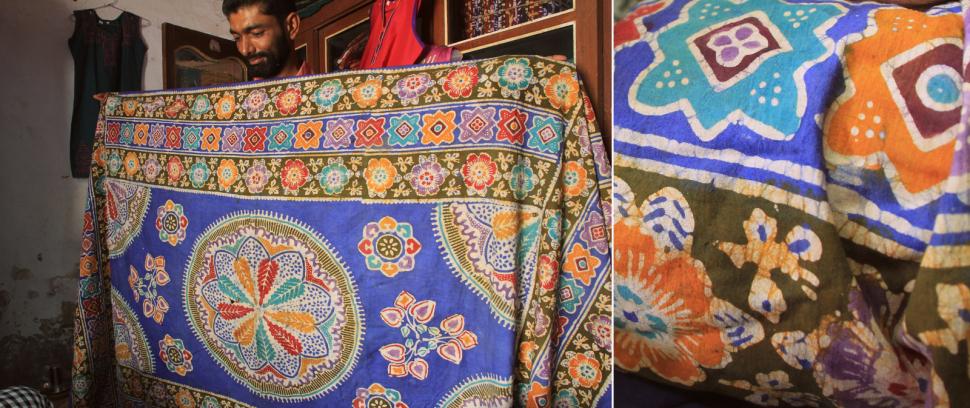Rooted in Tradition

Traditional Batik Sadla (Saree), East Kachchh | Batik fabric at a workshop in Mundra, South Kachchh
Local legends share stories of the Batik practice of block printing being carried to Kachchh during the time of the Ramayana by seasoned, master craftsmen. For years, people have enjoyed the floral and figural motifs of Batik textiles by Khatris, a community creating Batik, Ajrakh, Bagru and Bandhani all over Kachchh. The port of Mandvi is one reason Batik probably became a main industry in Kachchh. It was a popular textile export to Indonesia from Gujarat as early as the 1500’s. Indonesian populations were particularly fond of the Gujarati madder, a deep red colored dye that was meaningful to their community.
A Craft in Transition
Originally, Batik prints were made by dipping a block into hot piloo seed oil, which was then pressed onto fabric. After dyeing, the oil paste was peeled off to reveal a print. Over time, wax was adopted in the technical process of Batik printing as a more practical alternative to oil, which had to be pressed from thousands of small seeds. The adoption of wax changed the appearance of the textile. In wax printing, thin webs of dye run through the motif creating a beautiful veined appearance. Wax print batik flourished in Kachchh in the 1960’s due to the crafts rising popularity in foreign markets coinciding with the hippie movement and the emergence of chemical dyes, which worked in tandem with wax printing in contrast with vegetable dyes that were unfit for Batik making.

An artisan from Mundra shows a traditional batik bedspread made by his father | Batik fabric showing cracks in the design
Batik artisans today are struggling to stay afloat in a modern and competitive marketplace. Their style of printing is oftentimes replicated by screen and laser printers, who can make textiles in larger quantities to sell in bulk. Post-60’s the popularity of Batik has faded, often associated with that decade rather than with modern, high fashion. In Kachchh, communities that once wore Batik are more eager to buy mill cloth that is available for cheap prices in the local marketplace.
Room for Growth
Before Khamir, Shri Vivekanand Gramodyog Society worked for many years already to revitalize Batik.
Khamir intervenes by working with artisans to adopt new blocks, patterns, and collaborators so that Batik printers modernize their craft and make it saleable. Khamir has also taken steps to document and archive oral histories of Batik in this region, which will sustain the legacy of the craft as a source of knowledge, inspiration, and history for future Batik printers and user communities. Through understanding the marketplace, Batik craft will be sustained.
Read about the our 2014 exhibition honoring the Batik printers, Kachchh Ji Chhaap.